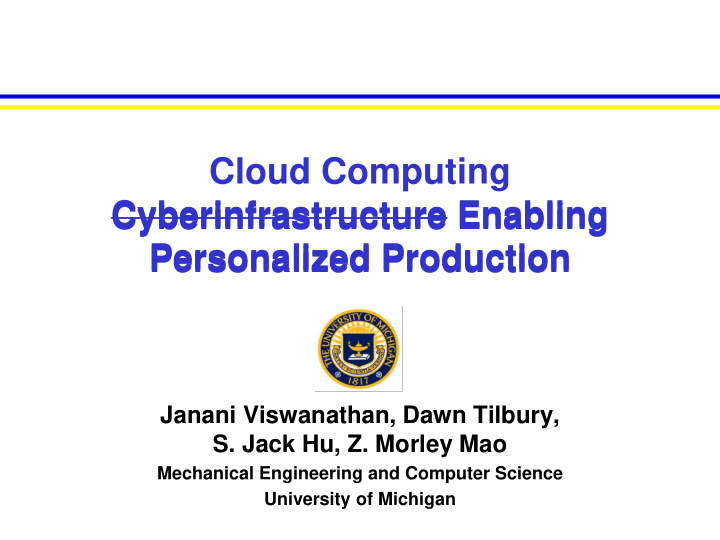



Cloud Computing Cyberinfrastructure Enabling Cyberinfrastructure Enabling Personalized Production Personalized Production Janani Viswanathan, Dawn Tilbury, S. Jack Hu, Z. Morley Mao Mechanical Engineering and Computer Science University of Michigan
Outline • Potential of Cloud Computing • Cloud Computing in Manufacturing • Examples and Case Study • Further Needs • Conclusion 2
Cyberinfrastructure Definition Cyberinfrastructure consists of “computing systems, data storage systems, advanced instruments and data repositories, visualization environments, and people, all linked by high- speed networks” Web-based cyberinfrastructure has revolutionized many businesses (e-commerce) What is the potential for manufacturing? 3
E-commerce success stories • Use of cookies in HTML – Transformed the web from being reactive to being integrative • Application Service Providers – Payroll, database, inventory services with web- based interfaces – “Mash - ups” leveraging APIs to use with Amazon/eBay for sales – “Pay what you use”, not software licensing What are the challenges to address? 4
Manufacturing needs • Breakdown product into components – Manually (or by historical experience) • Choice of suppliers – Search (facilitated somewhat by the Internet) – Personal judgment • Design assembly system • Validate product quality Which existing cloud computing technologies can be adapted for manufacturing systems?
Cloud computing opportunities • Distributed enterprises – Network of mfg companies that simplifies the supplier identification process for smaller companies – Standard interfaces for small & large companies to specify their needs & capabilities • Product customization/ personalization – Customer interaction – Product tracking • Low- and high-volume production
Cloud computing in Manufacturing Integration of suppliers & consumers 7
Case Study: Traditional Mfg. • Hierarchical • Individualized arrangements with suppliers • Little product personalization 8
Case Study: Cyber-Distributed Mfg 9
Case Study: Cyber-Distributed Mfg 10
Example: Personalized Shoes • ITIA-RTDI shoe factory • Offers suppliers an Intranet Supply Chain Management (SCM) Module that loads order specific CAD/CAM – Also gives supplier feedback about the process
Gaps in Supplier Integration • Common standards and architectures for parts to be made and mfg services – Validation that requests can be met – First-order estimate of cost to produce • High-level scheduler that can leverage multiple different suppliers • Privacy and proprietary protection – How much information needs to be presented? – How can a high-level scheduler account for core competency advantages of one supplier over another?
Case Study: Cyber-Distributed Mfg 13
Example: Local Motors • Consumers design a car body – Collaborating with other consumers and experts • Winning design is selected by “crowd” • Mini-factories for local production – Supply chain for engine, chassis, etc. – Hand assembly
Gaps in Consumer Integration • How to handle designs by the public? – Do customers really know what they want? – What tools can customers use to design? – Can you validate safety, quality, reliability? • Assembly of highly-variable products – Requires highly flexible production line – Product tracking, process monitoring • Ownership of design, rights to market
Further Needs • Cloud computing characteristics: – Openness – Scalability – Reconfigurability • Standards for integration of different data and data types within and across factories, and to consumers • Architecture of a manufacturing cloud 16
Conclusion • Large potential in leveraging existing cloud computing for manufacturing – Reduce time to market for new products – Reduce barriers to entry for new companies – Enable personalized production • Standards to define information exchange – Define the product, define the process – Protect proprietary interests • Validation of “unique” products 17
Case Study: Cyber-Distributed Mfg 19
Example: Siemens/Microsoft Innovative Production Line (IPL) • Orders automatically routed to available mfg plant • ERP (Enterprise Resource Planning) system checks inventory, orders parts
Gaps in Enterprise Integration
Cyberinfrastructure in Manufacturing Cyberinfrastructure has the potential to simplify and streamline the design, integration and operation of manufacturing systems by creating a distributed network that: – integrates various manufacturing companies and their suppliers. – provides a collaborative environment across a number of physical locations through web based virtual communities. 22
Challenges in Manufacturing • Development time for start-up companies • High Start-up cost / investment / time • Switching High/low volume mix in personalized production. 23
CI in Manufacturing 24
Recommend
More recommend